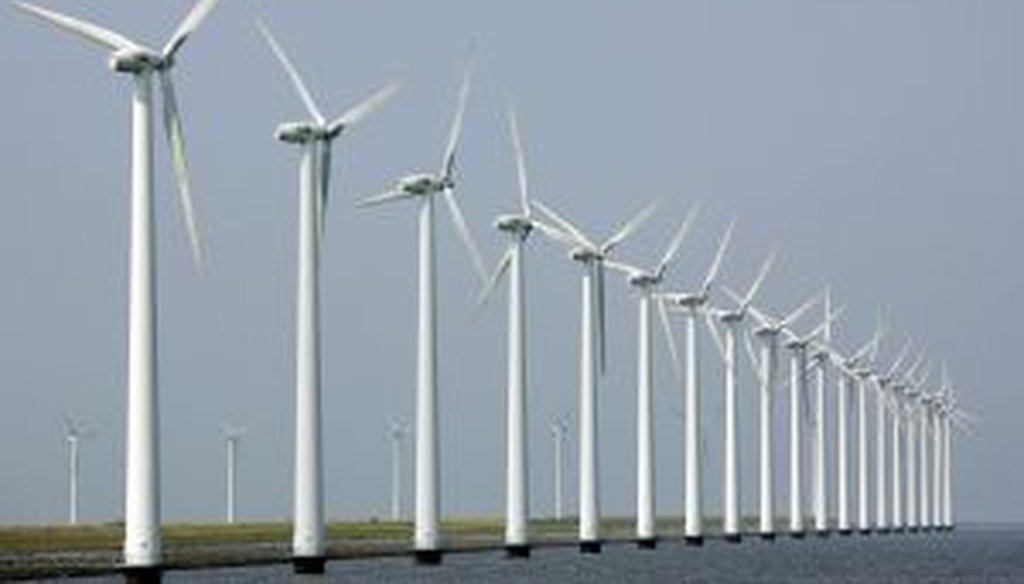Stand up for the facts!
Our only agenda is to publish the truth so you can be an informed participant in democracy.
We need your help.
I would like to contribute

Wind turbines can be hazardous to birds.
In a discussion of the massive oil spill in the Gulf of Mexico on ABC's This Week on May 2, 2010, the topic of alternative energy options -- including wind farms -- was raised.
Which prompted this comment from conservative panelist George Will: "By the way, wind farms kill a lot more birds daily than are probably going to be killed in this oil spill."
We got a lot of e-mails from readers asking us to investigate the truth of this claim. Environmental experts we talked to said it's just too preliminary to make any kind of meaningful forecast about the number of birds that may be killed by this still developing situation in the gulf. So we didn't feel it was appropriate to put this comment on the Truth-O-Meter. But we did think it would be useful to put the prediction in some context.
The issue of birds killed by wind farms first came to the forefront in the mid 1980s when a number of raptors were killed by the turbines at the Altamont Pass Wind Farms near San Francisco. Officials at the American Wind Energy Association note that newer wind technology introduced in the ensuing decades has greatly reduced the risk to birds. And they say that even with greatly expanded wind development in the future, bird deaths from wind energy are unlikely to ever be more than a small fraction of bird deaths caused by collisions with buildings or even lethal encounters with domesticated cats.
Nonetheless, wind turbines do kill birds.
The latest independent reports estimate the number of birds killed by wind turbines at about 100,000 per year. That's according to a 2007 report from the National Research Council called "Environmental Impacts of Wind-Energy Projects."
The American Bird Conservancy estimated in 2003 that between 10,000 and 40,000 birds were killed each year at wind farms across the country, about 80 percent of which were songbirds and 10 percent birds of prey.
"With the increased capacity over the last seven years, we now estimate that 100,000 – 300,000 birds are killed by wind turbines each year," said Conservancy spokesman Robert Johns.
By our math, that comes to 274 to 822 birds a day killed by wind farms across the country.
So is that more or less than the number of birds that are likely to be killed by the oil spill in the gulf?
"According to official records, so far there has been one bird killed in the spill," said Steve Rinehart, a spokesman for BP.
It was a northern gannet, he said, and it's the bird many people have seen in TV news reports being cleaned by a veterinarian.
"Birds tend to be more concentrated along the shore line," Rinehart said. "Location matters, and so far, this spill has been held out to sea."
Still, he allowed, the toll on birds could be significant if or when the oil slick reaches the coast.
"Obviously, oil spills pose a danger to wildlife," Rinehart said.
Environmental experts we spoke with said the oil spill is likely to have a devastating impact on birds. But quantifying that at this point is almost impossible to forecast.
"Comparing that to the gulf spill is difficult, if not impossible, for two reasons," said Johns of the American Bird Conservancy. "One, we don’t know when the hole will be plugged – sooner or later; and two, what never gets counted when you think about bird deaths on occasions like this, is how many birds never get born, because their habitat is destroyed (read oiled). So while we would estimate that probably tens of thousands of birds will die from the gulf spill (assuming the well gets shut down quickly), we have perhaps a larger concern about habitat destruction and long terms impacts to future bird generations.
"Regarding the spill, just remember that there will be many, many birds that will die and never make it to land to be counted," Johns said. "They will die at sea. Many types of birds are not land birds, so you won’t see them unless you are in the ocean. The spill is the size of Connecticut. Some birds will land in the goo, others will try to dive through it for food. Others may not dive through it for food and may starve. They won’t fly to land for help because it is not their nature. Sadly, they will simply die in the ocean."
So while it is impossible at this point to accurately estimate the numbers of birds that may be killed by the oil spill, Johns said, there is no doubt the total will dwarf the number of birds killed daily by wind farms.
By comparison, the Exxon Valdez oil spill in Alaska 21 years ago caused the death of 250,000 sea birds and 250 eagles, according to "best estimates," said Bruce Woods, a spokesman for the U.S. Fish and Wildlife Service in Alaska.
But it would be wrong to extrapolate that spill to the one now mushrooming in the gulf, he said. The number of birds killed depends on myriad factors, including the ultimate size of the spill, migratory patterns in the region, and the types of species in the area.
"I wouldn't want to speculate," Woods said of the number of birds that may be killed by the oil spill in the gulf.
Still, a news release from the U.S. Fish and Wildlife Service released this week said, "Service personnel are concerned that many species of wildlife, some already threatened or endangered, face grave risk from the spill." In Louisiana's Breton National Wildlife Refuge, which is threatened by the oil slick, a recent survey found more than 34,000 individual birds including 2,000 pairs of brown pelicans; 5,000 pairs of Royal Terns; 5,000 pairs of Caspian Terns; and 5,000 pairs of nesting gulls and other shore birds.
Those numbers offer some perspective on the potential loss. We can't make a Truth-O-Meter ruling, because the events are still unfolding. The ultimate truth of Will's comment will be decided by the currents, the winds, and the extent of the damage.
Our Sources
ABC News, 'This Week' Transcript: McKay, Napolitano, Salazar and Allen, May 2, 2010
Focus on Energy, Wind turbines and birds: Putting the situation in perspective in Wisconsin
American Bird Conservancy, Mortality Threats to Birds - Wind Turbines, 2003
U.S. Fish and Wildlife Service, Deepwater Horizon Oil Spill Response, May 1, 2010
U.S. Fish and Wildlife Service, Guidance on Avoiding and Minimizing Wildlife Impacts from Wind Turbines, May 13, 2003
National Academies Press, Committee on Environmental Impacts of Wind Energy Projects, National Research Council, 2007
National Wind Coordinating Committee, Avian Collisions with Wind Turbines: A Summary of Existing Studies and Comparisons to Other Sources of Avian Collision Mortality in the United States, August 2001
American Wind Energy Association, Facts About Wind Energy and Birds, 2001
U.S. Fish and Wildlife Service, Migratory Bird Mortality, January 2002
Interview with Tom Vinson, Director of Federal Regulatory Affairs American Wind Energy Association, May 3, 2010
Interview with Robert Johns, spokesman for the American Bird Conservancy, May 3, 2010
Interview with Alison Smith, Media & Communications Coordinator Stantec, May 3, 2010
Interview with Bruce Woods, a spokesman for the U.S. Fish and Wildlife Service in Alaska, May 3, 2010












































